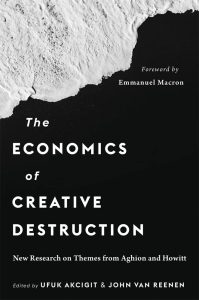John Van Reenen introduces his new book, The Economics of Creative Destruction, co-edited with Ufuk Akcigit, which explores how technological innovation can be used to drive growth and tackle problems from inequality to climate change.
The Economics of Creative Destruction. Ufuk Akcigit and John Van Reenen (eds.). Harvard University Press. 2023.
 Last month, Harvard University Press published my book The Economics of Creative Destruction (joint with Ufuk Akcigit, Harberger Professor at the University of Chicago).
Last month, Harvard University Press published my book The Economics of Creative Destruction (joint with Ufuk Akcigit, Harberger Professor at the University of Chicago).
The book is all about understanding technological innovation as the primary driver of economic growth. Although it is fashionable at the moment to bash growth, no country has successfully raised itself out of poverty without sustained economic growth. Innovation creates higher productivity – more output per hour – that means we can enjoy the same standard of living using less fossil fuel. This is vital if we want to tackle global warming: we need to accelerate both the rate of technical change and also steer technology in a cleaner direction. This was a major theme of LSE Environment Week, which I helped organise this month. Higher productivity growth gives options – we can work fewer hours and enjoy more fiscal firepower to reduce inequality.
Higher productivity growth gives options – we can work fewer hours and enjoy more fiscal firepower to reduce inequality.
Even those who accept the desirability of innovation fret that there is little that can be done to influence it, and that all humanity can do is adapt to the new normal of low wage and productivity growth that began after the Global Financial Crisis a decade and a half ago. I don’t agree with this pessimism. We reject the traditional economics approach that viewed technological progress as “manna from heaven” given to us by heroic and idiosyncratic entrepreneurs and inventors. We argue that innovation is profoundly influenced by the economic, political, social and cultural environment and therefore it is amenable to policies that can stimulate (or retard) growth
Innovation is by nature creative – ideas that are new to the world and can be commercialised, changing the economy in fundamental ways. […] But it is also destructive – these new ideas make old ones obsolete.
The term “creative destruction” was popularised by the Austrian economist Joesph Schumpeter writing in the inter-war period. Innovation is by nature creative – ideas that are new to the world and can be commercialised, changing the economy in fundamental ways. Entrepreneurial new entrants generate new jobs and sources of wealth – a light side. But the dark side of innovation is that it is also destructive – these new ideas make old ones obsolete, and in the process, incumbent older firms go bankrupt and workers lose their jobs.
Competition between firms drives down prices towards cost, which is good for consumers. But the incentive to create innovations through research and development (R&D) rests on earning, at least for a while, some monopoly profits.
The interplay between these two faces of innovation determines the opportunities and challenges for growth. Competition between firms drives down prices towards cost, which is good for consumers. But the incentive to create innovations through research and development (R&D) rests on earning, at least for a while, some monopoly profits. For example, pharmaceutical companies spend hundreds of billions of pounds on R&D searching for new drugs. Once discovered and taken through expensive clinical trials and the regulatory process, the cost of producing successful drugs is usually very low. If competition forced pharma firms to price their medicines at production cost, they would spend very little on medical R&D in the first place. This is why we have a patent system giving companies temporary monopolies and why governments (usually) do not force the price of new drugs down to costs.
A good competition policy (and a strong democracy more generally) is a lot about trying to create meritocracy in business
Unfortunately, firms with such market power will often try to abuse it. They will put up extra barriers to new firms coming in with new products to destroy their own positions or lobby governments to give them some extra protection against the upstarts. In the pharmaceutical example, they may try to buy up their potential rivals before the start-ups become a threat (even killing off promising new drugs). By tilting the playing field towards themselves, incumbents stymie growth. A good competition policy (and a strong democracy more generally) is a lot about trying to create meritocracy in business, so that there is a level playing field for all to compete. This theme of how politics intertwines with economics is a current that runs throughout our book.
Schumpeter was not modest. He once said “Early in life I had three ambitions. I wanted to be the greatest economist in the world, the best horseman in all of Austria, and the greatest lover in all of in Vienna.” Apparently, those who knew Schumpeter as an economist, lover or a horseman presumed his skills were in the other two fields! Nevertheless, he disliked formalising his ideas, and this was partly why his work only had a subterranean influence on the economics profession. Lord Acton remarked that his writings were like an entertaining, but infuriating, after-dinner speech.
In the early 1990s, “endogenous growth theory” was born, formalising innovation as the conscious outcome of profit maximising firms investing in R&D
In the early 1990s, “endogenous growth theory” was born, formalising innovation as the conscious outcome of profit maximising firms investing in R&D rather than a purely exogenous process of the animal spirits of scientists and entrepreneurs. My co-author, the Nobel laureate Paul Romer, made important contributions focusing on how there will be under-investment in R&D in a capitalist economy because firms cannot capture all the benefits of their R&D. It spills over to other firms who copy and build on the new knowledge. This emphasised the creative role of innovation. Aghion and Howitt went beyond this in 1993, formalising Schumpeter’s work in modern growth theory which also embraced the destructive (or business “staling”) aspect. The work opened up a vista of opportunities to investigate the creative destruction of innovation and our book illustrates many of the developments since then.
The book is a mixture of analytic overviews of research areas as well as new theoretical and empirical contributions.
Our book is quite a tome at 768 pages: less a coffee table book, than a coffee table in itself! Fortunately, a reader can easily dip in and out of the book like an intellectual lake. It has 28 self-contained chapters, some written by us, but mostly by others, including a forward by President Macron. The book is a mixture of analytic overviews of research areas as well as new theoretical and empirical contributions. A great strength of the Aghion-Howitt framework is that it has a natural role for using micro-economic data on firms and individuals, as the impact of innovation varies tremendously between the winners and losers.
There are eight sections in the book. We start with the role of competition as this is the key way that the creative destruction paradigm departs from conventional economics allowing a negative as well as positive role for product market rivalry. The second part focuses on inequality – we worry about the rise in inequality and the way in which people born into low wage families and communities struggle, even when they have the potential to become the innovators of the future
Transitioning to a green economy will require clean innovation and directing technical change away from dirty technologies
The next part of the book focuses on the recent decline in growth and the challenge of climate change. We argue that transitioning to a green economy will require clean innovation and directing technical change away from dirty technologies – it cannot be achieved by just carbon taxes, regulation and de-growth. We look at a wide range of policies from green investment incentives in the style pursued by the Biden administration, to clean research subsidies, to geo-engineering solutions and culture change.
Although politics runs throughout the book, we have four chapters focusing directly on institutions and governance, showing how these can strongly influence the way incumbents resist change, particularly in emerging economies. The final chapters deal with financial markets, taxation and changes in fundamental science.
Some parts of the work are technical, but mostly it can be read by more casual readers. If you want an intravenous shot of where we are in understanding the technological frontier, The Economics of Creative Destruction is the place to get it.
Note: This review gives the views of the author, and not the position of the LSE Review of Books blog, or of the London School of Economics and Political Science. The LSE RB blog may receive a small commission if you choose to make a purchase through the above Amazon affiliate link. This is entirely independent of the coverage of the book on LSE Review of Books.
Image Credit: Bilanol on Shutterstock.







